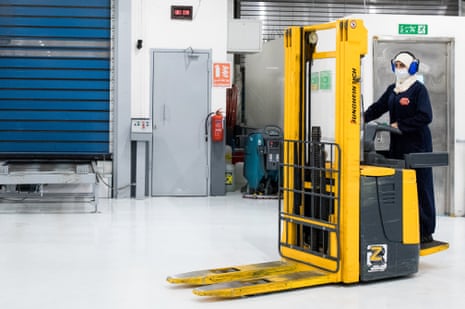At the Luna food factory on the south-east outskirts of Jeddah, Mashael Elghamdi sits at her computer in an artfully ripped AC/DC T-shirt and jeans. The faint whirr of machines processing cans of beans, cream and evaporated milk can be heard over the sound of eight women typing and sometimes laughing. A screensaver of a smiling Cameron Diaz gazes out from one corner of the room. This is an all-female office. And because there is no need for the full-length abayas women are legally required to wear when interacting with men at work or in public, it is a riot of colour.
On the factory floor below, women in custom-made overalls on an all-female production line apply labels to cans. “All the women you see here do everything themselves,” says supervisor Fatima Albasisi, who oversees 90 workers. A staircase and a corridor separate the female factory workers from their male counterparts, while the men-only offices are in a different building. “If there’s a problem with the machines, they can fix it,” Albasisi adds. “If I could, I’d have a factory entirely run by women, no men at all. In my experience, women show up to work on time and make fewer mistakes.”
The Luna food factory has been segregated since women began working as administrators here eight years ago. On the factory floor, the first 40 women started in 2013. “We work harder than the men,” Elghamdi tells me, back in the office. “For me, it’s better to be separate. If we work with the men, I have to wear my abaya and my niqab – it’s less comfortable.” She works in data entry, but also oversees worker safety for women. “It’s easier for them to tell me what they need,” she says. “It’s hard to go to the men.”
Not all offices or factories in Saudi Arabia are gender-segregated; it hasn’t been a legal requirement since 2005. But many employers continue to separate the sexes, to balance the conservative values of a majority-male workforce with the country’s apparent desire to get more women into work. As the physical barriers come down in other social settings, women-only workspaces are a symbol of both the future and the past; the question of whether they are a necessary step towards full female participation remains a murky one.
Saudi women have long worked, but in very limited numbers. According to the World Bank, women’s share of the labour force increased less than 7% between 1990 and 2018, now accounting for 16.8% of total workers. Saudi Arabia’s own estimates put this figure higher, at 22%.
Saudi officials have promised to overhaul the economy, weaning it off its dependence on oil, which accounts for an estimated 50% of gross domestic product. Key to this is a pledge to boost domestic employment and, in particular, the percentage of women, which it wants to reach 30% by 2030. Last year, the kingdom outlined “steps towards women’s full participation in society”, such as allowing them to attend sports matches.
Saudi law specifies that women may work only in “fields suitable to their nature” and prohibits them from jobs considered “detrimental to health” or “likely to expose women to specific risks”. In practice, these opaque rules are often interpreted by employers as a means of banning women from anything physically challenging. (At the Luna factory, tasks such as moving heavy boxes are restricted to the men’s section.) A Women in the Workplace initiative, launched in January, requires that women be given separate spaces to work if they ask for them; prevents women from being left alone with male colleagues; and mandates that women can work as cleaners or in room service only at all-female hotels or resorts.
If Saudi officials are to be believed, greater reforms are on the horizon. Recent changes – such as repealing a ban on women driving – are intended to signify the kingdom’s readiness to modernise. A 2016 directive also cut the power of the religious police, the Commission for the Promotion of Virtue and Prevention of Vice, who once watched over women’s behaviour in public: they are now unable to arrest women for crimes such as mixing with men who are not family members, or to berate them for showing their bare hands. The contrasts can be jarring: a Nicki Minaj concert originally scheduled for this month in Jeddah drew the ire of Saudi women, angry at Minaj being able to perform – “to go and shake her ass… and then you tell me to go and wear the abaya”, one Saudi woman said in a video posted to Twitter, viewed more than 37,000 times. Minaj has since cancelled her appearance, citing her support “for the rights of women, the LGBTQ community and freedom of expression”.
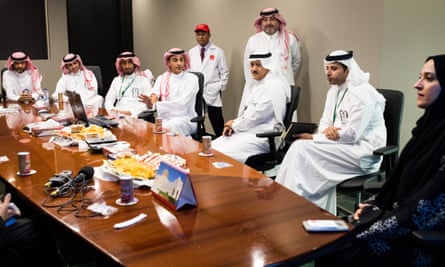
For Prince Mohammed bin Salman, heir to the throne and de facto ruler, known as MBS, women’s participation is the embodiment of a new Saudi Arabia. The murder of journalist Jamal Khashoggi last year, and the subsequent cover-up, may have combusted much of the kingdom’s carefully crafted image on the international stage. But MBS remains powerful, despite the CIA’s assessment that he personally ordered Khashoggi’s killing. His mantra of change filters down from on high; everyone I speak to, from street vendors to government officials, tells me, “Things are different now.” They may not always be speaking freely – a female minder accompanies me on official appointments.
This is a country where society is shifting far more slowly than the official rhetoric. While the Women in the Workplace initiative demands equal pay for equal work, a hefty pay gap remains. Saudi women are paid, on average, 56% less than men; the kingdom ranked 145th out of 149 countries in last year’s Global Gender Gap Index.
Long before Khashoggi’s murder, there were brutal efforts to silence critics or anyone pushing for deeper reforms. According to Amnesty International, 104 people have been executed this year. The kingdom has conducted “an unprecedented crackdown on the women’s rights movement”, Human Rights Watch says – last year arresting and prosecuting 11 women who pushed for the right to drive before it was legal, or simply spoke out against laws restricting women. According to human rights groups and their families, the women were subjected to brutal torture, including waterboarding and electric shocks. Seven have been bailed this year; all await sentencing for “coordinated activity to undermine the security, stability and social peace of the kingdom”.
Against this background, women-only spaces are a powerful visual signifier of change, positioning women as symbols of the new Saudi Arabia. But what do they mean to the women themselves, caught between the state’s promises and their own daily struggles to navigate a conservative society?
An hour north of Jeddah on the Red Sea coast, diggers churn the sandy earth on a flat, barren plain beneath an unforgiving midday sun. There is little more to see than the sparkling turquoise-tinted glass of an empty administrative office, but the site is touted as the future of female employment in the kingdom, an “oasis” designed for women. The complex will include 48 factories producing medical supplies, food and technology.
Saudi Arabia’s Industrial Property Authority, or Modon, originally raised the idea of industrial parks exclusively for women in 2012, when it announced the development of a “women-only city” in Al-Ahsa, east of the capital, Riyadh. This “oasis”, it said, was designed “for women workers in [an] environment and working conditions consistent with the privacy of women according to Islamic guidelines and regulations”. In 2015, Modon announced a further four similar sites across the country. Little is publicly known about the success or conditions of the first; Modon resists my efforts to visit or speak to women working there.
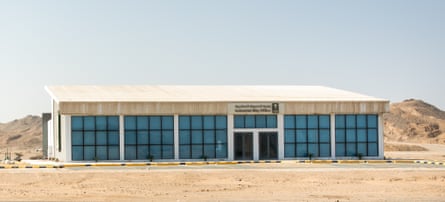
By the time construction had begun near the more progressive city of Jeddah, the government rhetoric around women’s rights and “privacy” had shifted. The Jeddah “oasis” will be “an environment that will encourage women to work”, but one where men will also be permitted, says Bandar Al-Toaimi, Modon’s communications director, gesturing at the open space as we tour the site. He says any decisions about features that could attract female workers, such as segregation, are “up to the ministry of labour’s rules and regulations”. Have any women been consulted about the design? Toaimi says he will check with the project department, but does not respond to follow-up emails. After months of detailed negotiations about my visit, I expected to see a 5 million sq m site, the foundation of a metropolis. But the complex is little more than a network of roads connecting piles of sand.
Toaimi argues that the industrial park will be “a big enabler in the recruitment of females in Saudi Arabia”, as our four-wheel drive speeds along freshly built roads. Like al-Ahsa oasis, the Jeddah complex will feature a nursery and, potentially, a bus to help women get to work – though Toaimi adds dismissively that “transportation now is not an issue – women can drive”. Exactly how many isn’t clear: I fail to spot any female drivers in Riyadh or Jeddah when I visit, although a few women tell me they have obtained their licences and are cautiously starting to drive. In the months that follow, Saudi women say driving is starting to become the norm.
Toaimi is upbeat about international investment but light on the details as he points out a cluster of shuttered grey factories around empty parking spaces. “We will give incentives to encourage investors to come – and ensure they have a good number of women working there. Maybe even a full facility,” he says.
This might be welcome news to some foreign executives, such as Tim Cook of Apple, who last year requested reassurances from Saudi authorities that, should they invest in the kingdom, they would be spared prosecution for setting up mixed-gender workplaces. Apple opened its first shop in Riyadh’s King Khalid airport last July, but any suggestion of a wider rollout has stalled. Saudi officials hope the tech giant will eventually join companies such as Unilever and Johnson & Johnson, who operate in the kingdom. The crown prince, MBS, has also courted Amazon to build data centres, but foreign companies have been hesitant to announce projects in Saudi Arabia since the Khashoggi murder. The Riyadh Chamber of Commerce says companies that choose to set up in the Jeddah oasis will benefit from longer leases and preferential government loans as a reward for hiring more women. But the details are vague: Toaimi can’t tell me how many women a business would need to hire in order to qualify. (Months later, I am told that companies will have to ensure at least 50% of their “manpower” comes from women – but it is unclear what sanctions, if any, those that fail to do so will face.)
The global trend for women-only spaces such as the US co-working startup the Wing, which recently expanded to London, women-only train carriages in Japan and a networking retreat in Finland might sometimes create a sense that the world is catching up with Saudi Arabia. But while gender-segregated offices proliferate there, few can claim to be founded by women for women.
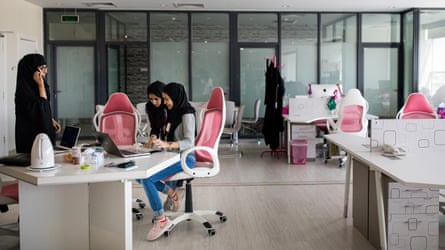
In the offices of SheWorks, Riyadh’s sole women-only co-working space, women work on business plans from hot pink office chairs, or perch on mauve sofas, bright against the dusty cityscape outside. If men visit for meetings or training sessions, they enter via a separate door to one of the walled-off meeting rooms behind frosted windows. The office sits atop a nursery, where women can leave their children while they work. “I picked this building specifically because there is daycare downstairs,” says founder Maha Shirah, who opened SheWorks in late 2014.
Shirah says SheWorks was a response to her own experiences in banking and hospital administration, where women from more conservative families were uncomfortable “talking to strange men”. Today, SheWorks functions as both a co-working space and an advisory service for women who are navigating the complexities of Saudi bureaucracy in order to start their own businesses. Women account for roughly 39% of all entrepreneurs in the country – higher than in other sectors because wealthy women often opt to set up their own business rather than work in fields dominated by men.
“There’s sort of a club vibe to it,” Shirah says of the space, looking at a nearby group clustered round a laptop. She adds that SheWorks hinges on the professional networks women build there, choosing to segregate themselves rather than being told to. “I decided to make this a women-only space because my customers wanted that,” she says, adding that she would change it if they wanted to admit men. SheWorks offers a relaxed environment where women can remove their abayas.
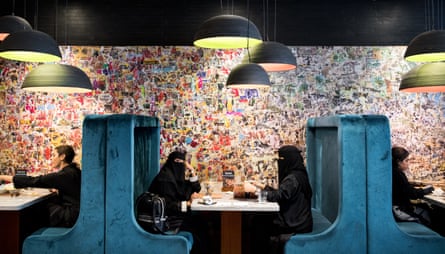
Shirah scoffs at the promises of privacy or protection that often accompany gender-segregated workplaces. “I don’t want privacy to be forced on me,” she says. “It’s just like when you force me not to drive. No, I want to have the option. And this is what all women want in the world.”
But women creating spaces to suit their own needs depends on increasing the number of female architects, a challenge in a country where women were prevented from studying the subject for decades, until 2011. Even now, “a lot of women graduating in architecture or interior design don’t have jobs,” says Haifa Al-Hababi, assistant professor of architecture at Prince Sultan University in Riyadh. Al-Hababi estimates that up to 15 women have government architecture positions, which she hopes will help increase wages and participation across the industry. She is positive about the knock-on effects of the recent reforms. “Before, you couldn’t spot any women walking along the street,” she says. “If you saw this, you’d have thought you were dreaming. Now, you see a lot of women using public space.”
Gender segregation took hold in Saudi Arabia as part of a wave of conservatism that spread across the Middle East in the 80s, after Iran’s Islamic revolution. For many, separation begins at a young age: all public schools are single sex, as are many universities, some of which beam lectures given by male professors into halls of female students by video link, or keep female students apart from their male peers on a mezzanine floor.
Education for women didn’t exist in Saudi Arabia until 1956 and, while women now make up more than 50% of university students, decades of de facto bans have influenced what they study. Until 2002, the body governing women’s education was still overseen by religious clerics who viewed it as training for motherhood. Subjects such as law and engineering were opened up to women in 2005 and 2011 respectively. It took even longer for pioneering graduates to get permission to work in their chosen fields: Saudi Arabia’s first female lawyer was finally allowed to practise in 2013. Although women make up 30 seats on the 150-member government advisory body, the Shura Council, and the country recently appointed its first female ambassador, such women are the exception and not the rule.
Saudi women are still legally classified as minors for their entire lives, under the guardianship system that entitles their husband or male relative to make decisions about matters such as travel on their behalf. Recent reforms mean women no longer need a guardian’s permission to start a business or open a bank account. In public places, the partitions that separate “families” from “singles” (meaning men) are slowly going out of style. But decades of tradition are not easily swept away. This remains one of the most segregated societies in the world, with strict norms on gender conformity. The law bans men from “behaving like women” and it is illegal to wear the clothes of the opposite sex.
At Kore gym in Riyadh, designed by a female architect and entirely operated by women since it opened last year, women train on fearsome-looking machines or crawl on the floor with bands across their legs as part of the “workout of the day”. In one corner, 18-year-old weightlifter Shirah Abdullah gulps water and chats with a friend between reps of lifting 200lb barbells. Asked what draws her to the space, she grins and says: “The community – it’s amazing here.”
Kore is one of a growing number of gyms for women made possible by a change in licensing laws – a rebuke to an earlier crackdown enacted by clerics who claimed that gyms would encourage women to leave their families. The owners of Kore say several new branches are planned. But this is not without risk; the Saudi General Sports Authority closed one such gym this year, claiming that a video on social media showing a woman exercising in tight sportswear was “promoting the gym disgracefully and breaching the kingdom’s code of conduct”.
The women-only basement of the Panorama mall in Riyadh stands deserted, with unlit window displays of pale lace ballgowns and wedding dresses in an empty space tinted soft pink by neon lights. The ministry of labour has identified retail as a target sector for increased female employment, but this part of the mall will soon make way for a cinema, another symbol of the new Saudi Arabia. The upstairs mall – now mixed gender – will remain.
Some women will miss segregation. Shop assistant Hanadi Faraj, rearranging gowns inside a friend’s boutique, tells me, “I don’t like working around men – I feel shy.” At the mall’s entrance, women wait for taxis next to a large mural merging MBS’s face with that of his father, King Salman. “I prefer women only,” says Yara Alfantoukh, a customer waiting outside with her mother. “It means I have more freedom.”
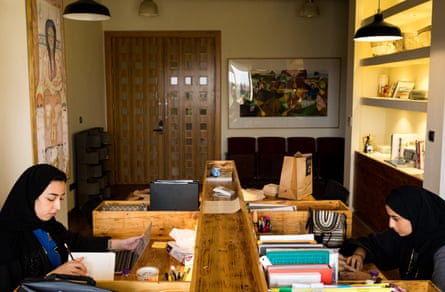
Other young women prefer to navigate the challenges of gender integration. “The problem is, a lot of people have never been in a mixed environment,” says physics student Nouf Jaber, 22, who is reading a Haruki Murakami novel on the grass outside a public library in Riyadh. She points out that Saudi Arabia introduced a new anti-harassment law in May, but women still have to battle a conservative culture to report problems. “It’s one thing at work, where there’s more respect – it’s another thing for people on the street,” Jaber says. “On the street, people aren’t afraid for their jobs.” Yet she is hopeful of a future without public segregation. “I don’t feel we should be separated in restaurants or malls – that’s what caused this problem in the first place,” she says. “Suddenly they removed the barriers and no one knows what to do – I met guys who were so nervous around women that they couldn’t speak.”
Jaber is considering job options for when she graduates, and recently visited the King Abdulaziz City for Science and Technology, where she saw no women in the building. “They told me they are starting to initiate female employment,” she says. “But it’s all just talk.”
One thing is certain: while the world of women’s work is evolving, public spaces are still dominated by men. As I leave a restaurant in Riyadh one evening, a large four-wheel drive pulls up next to me. “You must wear the hijab – cover your hair! Cover your hair!” a man roars, his voice filled with rage. The logo of the Commission for the Promotion of Virtue and Prevention of Vice is emblazoned on the car door. The officer looks over again in disgust, and drives away.
